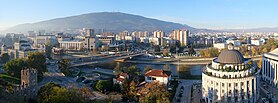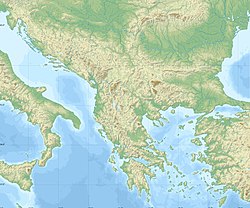
Back Скопие Abkhazian Skopje ACE Skopje Afrikaans Skopje ALS ስኮፕዬ Amharic Scopia AN إسكوبية Arabic اسكوبيه ARZ Skopie AST Skopye AVK
This article may require copy editing for grammar, style, cohesion, tone, or spelling. (October 2023) |
Skopje
| |
|---|---|
| Град Скопје Qyteti i Shkupit City of Skopje | |
View over central Skopje with the Vardar river | |
| Coordinates: 41°59′46″N 21°25′54″E / 41.99611°N 21.43167°E | |
| Country | |
| Region | Skopje Statistical |
| Municipality | Greater Skopje |
| Government | |
| • Type | Special unit of local self-government |
| • Body | Skopje City Council |
| • Mayor | Danela Arsovska (Independent)[1] |
| Area | |
• Greater Skopje | 571.46 km2 (220.64 sq mi) |
| • Urban | 337.80 km2 (130.43 sq mi) |
| • Metro | 1,854.00 km2 (715.83 sq mi) |
| Elevation | 240 m (790 ft) |
| Population (2021)[2] | |
• Greater Skopje | 526,502 |
| Demonym(s) | Skopjan[3] Macedonian: Skopjanec/Skopjanka Скопјанец/Скопјанка Albanian: Shkupjan (m), Shkupjane (f) |
| Official Language(s) | |
| • primary | Macedonian, Albanian |
| Time zone | UTC+1 (CET) |
| • Summer (DST) | UTC+2 (CEST) |
| Postal codes | МК-10 00 |
| Area code | +389 2 |
| ISO 3166 code | MK-85 |
| Car plates | SK |
| HDI (2021) | 0.802[4] very high · 1st of 8 |
| Climate | BSk |
| Website | www |
Skopje (/ˈskɒpjeɪ/ SKOP-yay,[5][6] US also /ˈskoʊpjeɪ/ SKOHP-yay;[7] Macedonian: Скопје [ˈskɔpjɛ] ⓘ; Albanian: Shkup, Albanian definite form: Shkupi) is the capital and largest city of North Macedonia. It is the country's political, cultural, economic, and academic centre. Skopje lies in the Skopje Basin.
Scupi is attested for the first time in the second century AD as a city in Roman Dardania.[8][9] When the Roman Empire was divided into eastern and western halves in 395 AD, Scupi came under Byzantine rule from Constantinople. During much of the early medieval period, the town was contested between the Byzantines and the Bulgarian Empire, whose capital it was between 972 and 992. In 1004, when it was seized by the Byzantine Empire, the city became a centre of a new province called Bulgaria. From 1282, the town was part of the Serbian Empire, of which it was the capital from 1346 to 1371.
In 1392, Skopje was conquered by the Ottoman Turks, who called it Üsküb (اسکوب).[a] The town stayed under Ottoman control for over 500 years, serving as the capital of the pashasanjak of Üsküp and later the Vilayet of Kosovo. Its central position in the Ottoman Balkans made it a significant centre of commerce and administration during the Ottoman era. In 1912, it was annexed by the Kingdom of Serbia during the Balkan Wars.[10]
During World War I the city was seized by the Kingdom of Bulgaria, and, after the war, it became part of the newly formed Kingdom of Yugoslavia as the capital of Vardarska Banovina. In World War II, the city was again captured by Bulgaria and in 1945 became the capital of SR Macedonia, a federated state within Yugoslavia.[11] The city developed rapidly, but this was interrupted in 1963 when it was hit by a disastrous earthquake.
Skopje is on the upper course of the Vardar River and is on a major north–south Balkan route between Belgrade and Athens. It is a centre for the chemical, timber, textile, leather, printing, and metal-processing industries. Industrial development of the city has been accompanied by development of the trade, logistics, and banking sectors, as well as an emphasis on the fields of transportation, culture and sport. According to the last official census from 2021, Skopje had a population of 526,502 inhabitants.[2]
- ^ "Local Elections 2021 – Mayor of Skopje State Election Commission". Archived from the original on 1 November 2021. Retrieved 1 November 2021.
- ^ a b Cite error: The named reference
stats2was invoked but never defined (see the help page). - ^ "Skopjan dictionary definition | skopjan defined". YourDictionary.
- ^ "Sub-national HDI - Area Database - Global Data Lab". hdi.globaldatalab.org. Retrieved 13 September 2018.
- ^ "Skopje". The American Heritage Dictionary of the English Language (5th ed.). HarperCollins. Retrieved 28 July 2023.
- ^ "Skopje". Merriam-Webster.com Dictionary. Merriam-Webster. Retrieved 28 July 2023.
- ^ Wells, John C. (2008), Longman Pronunciation Dictionary (3rd ed.), Longman, p. 747, ISBN 9781405881180
- ^ Syme, Ronald; Birley, Anthony (1 January 1999). The Provincial at Rome: And, Rome and the Balkans 80BC-AD14. University of Exeter Press. ISBN 9780859896320 – via Google Books.
- ^ Mócsy, András (1 January 1974). Pannonia and Upper Moesia: A History of the Middle Danube Provinces of the Roman Empire. Routledge & K. Paul. ISBN 9780710077141 – via Google Books.
- ^ Ramet 2006, p. 40.
- ^ John B., Bell, Martin, Conflict in the former Yugoslavia: an Encyclopedia, ABC-CLIO, 1998, p. 270, ISBN 0874369355.
Cite error: There are <ref group=lower-alpha> tags or {{efn}} templates on this page, but the references will not show without a {{reflist|group=lower-alpha}} template or {{notelist}} template (see the help page).











